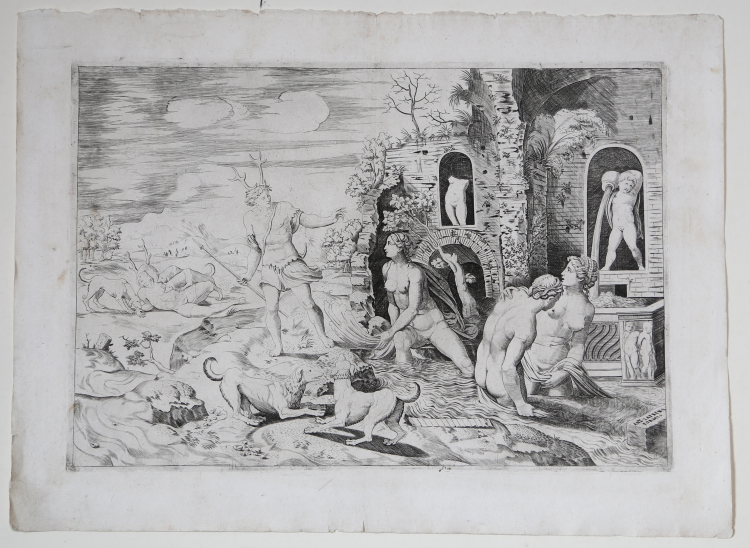





| Reference: | S48414 |
| Author | Giulio BONASONE |
| Year: | 1550 ca. |
| Measures: | 415 x 285 mm |




| Reference: | S48414 |
| Author | Giulio BONASONE |
| Year: | 1550 ca. |
| Measures: | 415 x 285 mm |
Diana, bathing with two nymphs in front of a classical ruin, throws water to Actaeon.
Engraving ca. 1550. Example in the second state, with the imprint “Ant Lafreri Romae” added on the stone at lower right.
A good impression, printed on contemporary laid paper with watermark “tulips in a shield with six-pointed star” (Woodward nn. 124-125), with wide margins, in excellent condition.
This is an invention print based on the episode from Ovid's Metamorphoses (III, 155), depicting the moment of the beginning of Actaeon's transformation into a stag and, in the background, the death of the hunter/deer mauled by his own dogs. The engraving was catalogued by Bartsch in 1813 as “School of Marcantonio Raimondi,” then in 1820 it was assigned by G. A. Armano to Bonasone. Stefania Massari in 1983 accepted this second hypothesis and included the work in Bonasone's catalog raisonné, proposing to date the execution of the work to about 1550.
As mentioned, the subject is derived from the text of Ovid's Metamorphoses (III, 155). The author simultaneously depicts two moments of the myth. The moment when Actaeon is driven away from Diana's nymphs and begins to turn into a stag as punishment for daring to look at the naked goddess Diana. The next moment, in the left background, in which Actaeon-deer becomes prey to his own pack of hunting dogs. A theme also addressed by Parmigianino, Luca Penni, and Primaticcio. It is a pretext for a refined reflection on the theme of love that is rooted in its own iconographic fortune in the seductive nudity of bodies, chaste and inevitably fatal. A reflection on man's passions that lead him to ruin: on Renè Boivin's engraving derived from Penni's drawing on the same subject we read: dominum cognoscite vestrum. Ovid recounts the episode as occurring in a naturally contrived forest with a cave and water features. Bonasone, like later Luke Penni, deviates from the text and inserts some classical ruins to form Diana's cave and pool. This is probably a “modernization” of the facts aimed at placing the scene in a landscape similar to the city of Rome at the time of the execution of the burin. In this sense the sheet must have appeared more interesting to an audience that liked to collect images of classical statues or architecture or images of Roman ruins and antiquities.
Bibliografia
Bartsch, XV.40.10; Massari, Iulio Bonasone, n. 118.
Giulio BONASONE (Bologna circa 1500 - Roma circa 1580)
|
Giulio Bonasone was born in Bologna in 1510; he was engraver, etcher and, as a painter, he was a pupil of Lorenzo Sabbatici.
The critics have ascribed to him 400 prints; nearly all of them are kept nowadays in the Institute of Graphic Design in Rome, widening the list of Bartsch, who had identified just 354 subjects. Bonasone started working in 1531 as copperplate engraver, as it can be seen from his S. Cecilia, and he was considered a follower of Marcantonio’s style in the last years. But Bonasone showed his own style quite soon, for Parmigianino asked him to engrave many of his works.
He lived in Rome between 1544 and 1547, working for the most important publishers of the time (Salamanca, Barlacchi, Lafrery), engraving subjects from Michelangelo, Raphael, Giulio Romano, Perin del Vaga and Polidoro da Caravaggio with his peculiar style.
|
Giulio BONASONE (Bologna circa 1500 - Roma circa 1580)
|
Giulio Bonasone was born in Bologna in 1510; he was engraver, etcher and, as a painter, he was a pupil of Lorenzo Sabbatici.
The critics have ascribed to him 400 prints; nearly all of them are kept nowadays in the Institute of Graphic Design in Rome, widening the list of Bartsch, who had identified just 354 subjects. Bonasone started working in 1531 as copperplate engraver, as it can be seen from his S. Cecilia, and he was considered a follower of Marcantonio’s style in the last years. But Bonasone showed his own style quite soon, for Parmigianino asked him to engrave many of his works.
He lived in Rome between 1544 and 1547, working for the most important publishers of the time (Salamanca, Barlacchi, Lafrery), engraving subjects from Michelangelo, Raphael, Giulio Romano, Perin del Vaga and Polidoro da Caravaggio with his peculiar style.
|